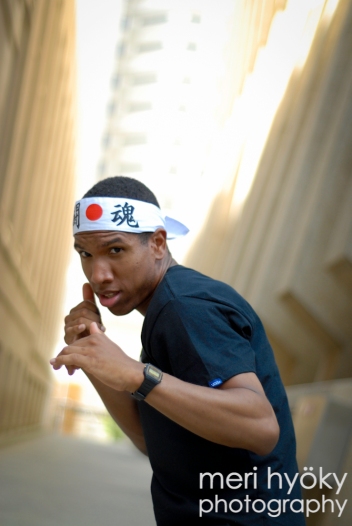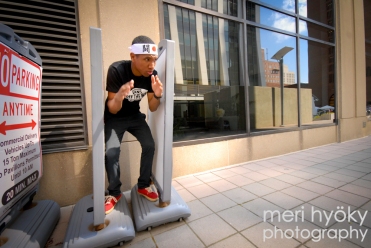Originally posted by Yes! Weekly
By Jordan Green
Johnny Collins, also known as Radio the Artist, is on a roll these days.
A resident of Kernersville, Radio has made some inroads as an artist in Winston-Salem over the past couple years, particularly with a mural he painted with students at Petree Elementary.
Then, last year, he hooked up with the 512 Collective, a group of High Point artists who share a gallery on Washington Street, and soon found an agent in Ryan Saunders, a social entrepreneur who is working on multiple fronts to whip that city into cultural relevance.
Saunders is helping Radio promote an upcoming solo show at Studio 7 in Winston-Salem’s vaunted Downtown Arts District. Slight, with a friendly demeanor, the 24-year-old Radio is a tireless promoter of his own work with a disarming eagerness to talk about his intentions and techniques. His use of Sharpies, ink pens, crayons and other proletarian implements has led at least one of his handlers to mistakenly bill him as a folk artist, but as the son of New York transplants, he’s keenly aware of the modernist traditions from whence his art springs.
His “square dude” character — a trisected square with rolled-back eyes and a lolling tongue — is nearly ubiquitous in the Triad, and hairless, egg-shaped heads proliferate in Radio’s visual work. His more recent work juxtaposes a pastoral naturalism through watercolors with chaotic human intervention through jagged line drawings.
Radio’s heavy emphasis on line recalls Keith Haring. His intuitive style developed through repetition of forms and tolerance for imperfection — almost a visual equivalent of the Beat poets’ spontaneous wordplay — takes a page from Jean-Michel Basquiat. Reaching back slightly further, Radio’s undiscriminating embrace of all sources references the pop art of Andy Warhol, also an inspiration for Haring.
They all flourished in the New York art scene of the 1980s — a convergence of underground street art, activism and high commerce, and died one by one — in 1987, 1988 and 1990.
Radio was born in North Carolina, his parents having migrated from New York for work, at about the same time that the scene fell away with the passing of Haring, Basquiat and Warhol. But his parents exposed him to their work. And Radio’s uncle was a graffiti and fine artist, who served as a family inspiration. Radio’s mother, whom he describes as “the hip lady,” regaled him with stories about encountering old-school hiphop celebrities like Kurtis Blow.
Reinforcing his pop leanings, Radio’s mom also turned him on to Hanna-Barbera cartoon reruns such as “The Flintstones,” “The Jetsons” and “Scooby-Doo!” that impressed him with their thick lines and bright color palette. His dad introduced him to Japanese animation, including “Speed Racer” and the forerunner of “Voltron.”
Radio embraces Haring’s affinity for social activism, speaking admiringly about the “Crack is wack” mural painted in East Harlem in 1986.
Today, Radio sees gun violence and homophobia as the social ills that need to be addressed.
Halos, crosses and crowns in Radio’s paintings typically represent power of some kind — civil, military or religious — a mark of distinction over looming figures that overwhelm the little people, represented by eggshaped heads crammed together.
“With the halos and crosses, they supposed to be good people, but they’re really not,” Radio said. “They’re oppressing the people. They’re not helping the people. All the things I’ve been hearing in the media about the governor and Congress, they’re supposed to be helping people, but instead they’re neglecting them.”
The one-story brick duplex where Radio stays in Kernersville might be a far cry from the cultural ferment of the 1980s New York art world, but it’s his scene.
“What I like about North Carolina as an artist is that, even though there’s not much to do, that’s the point: It’s like a blank canvass,” he said. “If I went to New York or California, those places are flooded with artists who are doing the same thing as me. I stand out here — like a sore thumb.”
The Greensboro Historical Museum screens a documentary by a group of Montagnard students, titled The Young ‘Mountaineers’: An Untold Story of Montagnard Youth in Greensboro, on Saturday from 1 to 4 p.m. The event also features quilted panels depicting the experiences of a young immigrant from Vietnam by Betty Stratford, an educator at Mendenhall Middle School.
Artist Ibrahim Said gives a talk about his work at the Bennett College Art Gallery at Steele Hall in Greensboro on Friday from 5 to 7 p.m.
The Arts Council of Winston-Salem and Forsyth County kicks off its 2014 annual campaign at the Milton Rhodes Arts Center on Thursday at 8 a.m.
The annual Bookmarks festival, which takes place in early September, is moving from the Downtown Arts District at Trade and 6 th streets, to the Milton Rhodes Arts Center, the organization announced on Tuesday.
Johnny and The Hub are plotting how to bring him to Lesotho for art workshops. Want to see murals by Radio! popping up around Lesotho? Let us know!
Radio! in Raleigh, NC with photographer Meri Hyöky:





















